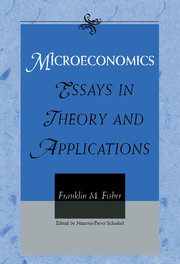Book contents
- Frontmatter
- Contents
- Introduction
- Part I Disequilibrium and Stability
- Part II Welfare Economics and Consumer Theory
- Part III Applications of Microeconomic Theory
- Part IV Industrial Organization, Economics, and the Law
- Part V Public Policy Applications
- Epilogue
- My Career in Economics: A Hindcast (1997)
- Indexes
My Career in Economics: A Hindcast (1997)
Published online by Cambridge University Press: 20 March 2010
- Frontmatter
- Contents
- Introduction
- Part I Disequilibrium and Stability
- Part II Welfare Economics and Consumer Theory
- Part III Applications of Microeconomic Theory
- Part IV Industrial Organization, Economics, and the Law
- Part V Public Policy Applications
- Epilogue
- My Career in Economics: A Hindcast (1997)
- Indexes
Summary
How I Wandered into Economics and Then to MIT
Most children do not grow up dreaming of becoming an economist, and I was no exception. I wandered into the subject.
I was born in New York City in 1934, the oldest of three children. My father, Mitchell S. Fisher, was a rabbi who became a prominent attorney specializing in divorce work. My mother, Esther Oshiver Fisher, had a law degree but never practiced. Eventually, she became a marriage counselor.
Despite a strong high-school training and interest in mathematics, I decided not to continue in that subject when I entered Harvard College in September 1952. One of my best friends was a mathematics genius and, although I was good, I plainly could not compare with him.
I began by majoring in philosophy but was quickly turned off by exposure to quite a bad teacher in that subject. By contrast, I had an excellent teaching assistant, Gavin Langmuir (later a professor of history at Stanford) for my instructor in a history-oriented social science course. History had always interested me, and I decided to become a history major.
One of the requirements for that major was a course in either political science or economics. At the beginning of my sophomore year, I consulted Langmuir and was strongly advised to take economics, political science being deemed “too easy”. I duly registered for Harvard's Principles of Economics course – Ec 1, as it was then called.
The course (which used the second edition of Paul Samuelson's text, Samuelson 1951) was a revelation to me in more than one respect.
- Type
- Chapter
- Information
- MicroeconomicsEssays in Theory and Applications, pp. 539 - 562Publisher: Cambridge University PressPrint publication year: 1999



